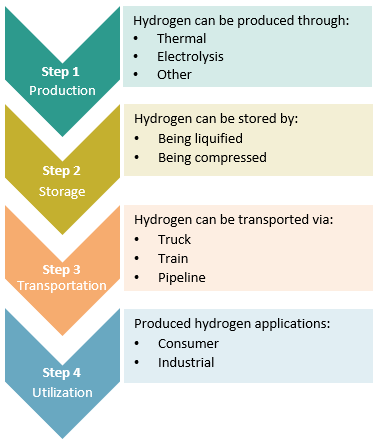As a vocal world leader in climate change, Canada has taken a proactive initiative in navigating a clean energy transition. In more recent times, hydrogen has been dominating the global headlines as a potential vital component of future energy sources. Hydrogen is perceived to be a critical component in combating climate change and creating economic prosperity while achieving climate objectives. In this article, we cover the types of hydrogen power, current hydrogen usage, uses and several Canadian players within the industry.
Overview
Hydrogen is the most abundant element in the universe. It is an energy carrier that can be used to store, transport and deliver energy produced from other sources. Hydrogen is considered a clean fuel as it only produces water when consumed in a fuel cell. Therefore, hydrogen is an attractive fuel option for transportation and electricity generation applications with the absence of carbon as a byproduct.
Hydrogen fuel today is primarily produced via a thermal process where steam reacts with a hydrocarbon fuel to produce hydrogen. However, this process receives scrutiny as it releases carbon emissions. In addition, hydrogen fuel can be produced via the electrolysis process. Water molecules are separated into its two components: oxygen and hydrogen. Using renewable electricity in the electrolysis process to split water molecules is widely considered the cleanest way to produce hydrogen. There are no direct emissions. Other production methods include biological and solar driven processes.
Types of Hydrogen
Hydrogen produced today can be classified into the following types:
In essence, brown and grey hydrogen production still releases carbon emissions, which impedes the decarbonizing purpose of clean energy. Despite that, most of the hydrogen produced today is still brown and grey hydrogen. Blue and green hydrogen are considered clean without carbon emissions. However, they only make up less than 1 per cent of the total hydrogen produced globally.
How Hydrogen is Produced, Stored, Transported and Used
Uses
As of today, hydrogen is primarily used in the following applications:
Mini Case Study: The hydrogen car
In this section, we investigate the pros and cons of a hydrogen consumer car. A hydrogen car converts compressed hydrogen into electricity, which is used to power the vehicle’s motor while only producing heat and water vapour, AKA “emission-free”.
Hydrogen is generally as safe as gasoline we put in vehicle fuel tanks. Although hydrogen is highly flammable, escaped hydrogen dissipates quickly and typically in a narrow column shooting straight up into the atmosphere. Its vapors do not pool on the ground unlike gasoline’s. Hydrogen cars are equipped with an array of hydrogen sensors that sound alarms and seal valves and fuel lines in the event of a hydrogen leak. In addition, hydrogen fuel stations store hydrogen above ground in well-vented areas. Therefore, it presents less fire or explosive danger today.
Despite the advantages, the main hurdle for hydrogen cars is the relatively high cost in purchasing and maintaining the vehicle, as well as the limited options and refueling stations currently available. In addition, low oil and gas prices are another deterrence delaying the mass commercialization of hydrogen cars.
Fun Fact: It is estimated that 6.5 million hydro fuel-cell vehicles will be sold by 2032, with take-up accelerating due to the growth in fueling infrastructure deployment.
Sourced from Research and Market
In Our Backyard
A. Government
Canada committed to reducing its greenhouse gas (GHG) emissions by 30 per cent below 2005 levels by 2030. In addition, the federal government aims to achieve net-zero emissions by 2050, a fairly ambitious goal. The hydrogen industry appears to be a contributing component in achieving these national objectives.
In October 2020, the federal government announced $10 billion in funding for infrastructure initiatives as part of its plan to boost growth and create employment opportunities following the economic impacts of COVID-19. Included in the plans are:
$2.5 billion for clean power to support renewable generation and storage and to transmit clean electricity between provinces, territories and regions, including northern and First Nation communities;
$2.0 billion for large scale energy efficient building retrofits; and
$1.5 billion to speed up adoption of zero-emission buses and charging infrastructure.
The federal government’s hydrogen strategy is seen to rely on a combination of blue and green hydrogen. These funding initiatives would support the continued push to hydrogen fuel as a cleaner energy source.
As natural gas producers, Western Canadian provinces are well positioned to benefit from the hydrogen push. As hydrogen is primarily produced from natural gas, provinces like Alberta and British Columbia already have the necessary core infrastructure in place to capitalize on hydrogen production. It seems like a no-brainer for natural gas producing provinces to produce hydrogen for about half the wholesale cost of diesel by upgrading natural gas or other fossil fuels. This can all be done while capturing the carbon dioxide byproduct, which can be permanently stored underground.
Alberta is seeking to lead the nation’s production of blue hydrogen. In its hydrogen strategy released in October 2020, the province identifies blue hydrogen as a key growth area as part of its economic diversification efforts. The province’s strategy includes large scale hydrogen production with CCUS and deployment of hydrogen fuel in various commercial applications by 2030. It also aims to export hydrogen and hydrogen derived products by 2040.
In provinces with more renewable energy sources like Quebec and Ontario, hydrogen can be produced from the electrolysis of water for about the same price as the wholesale cost of diesel fuel (Corporate Knights).
“By 2050, [hydrogen] is going to be a $2.5-trillion industry… We need to keep advancing this sector.”
B. Private Sector
We highlight several key Canadian players with material contributions to our nation’s hydrogen aspirations:
Hydrogen Technology & Energy Corp. - Built six retail hydrogen stations in BC (first in 2018), with more currently in progress.
Loop Energy - Develops hydrogen fuel cell range extenders for short and long-haul trucks; has secured contracts in China, including converting Nanjing’s municipal bus fleet to 100 per cent
Ballard Power Systems - Develops and manufactures hydrogen fuel cell products for various markets including heavy-duty automotive, portable power, material handling etc.
Proton Technologies - Developing process to produce low-cost hydrogen by injecting oxygen into abandoned oil reservoirs to combust unswept oil while leaving emissions released underground.
New Flyer Industries - North America’s largest transit bus and motor coach manufacturer offers the hydrogen fuel cell-electric Xcelsior CHARGE H2™ heavy-duty transit bus.
Conclusion
Hydrogen fuel appears to have the potential as an alternative energy source in the future; keyword, future. The truth is simple, we still need oil and gas to fuel our nation today. Switching to clean energy sources is not at a flick of a switch and will not be achieved overnight. Instead, it is a gradual process requiring additional investment and R&D before we arrive at this end goal. Hydrogen is a clean alternative and has the potential to play a more prominent role in our nation’s energy production in the future. With the current infrastructure and natural gas expertise, there are opportunities for Western Canadian based oil and gas companies to take advantage of and gradually diversify into this clean alternative energy source.

















